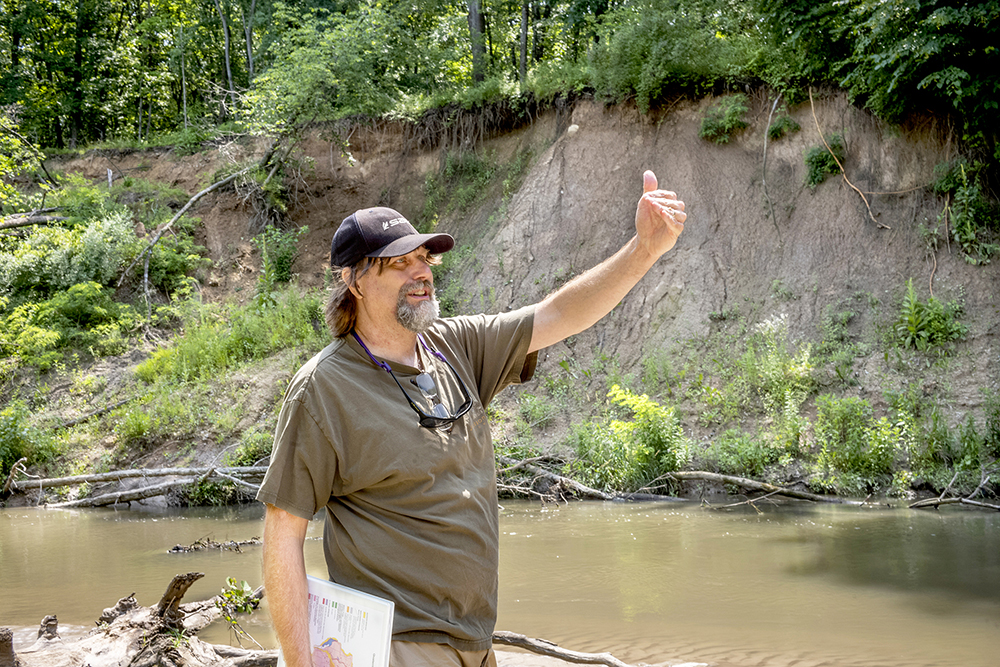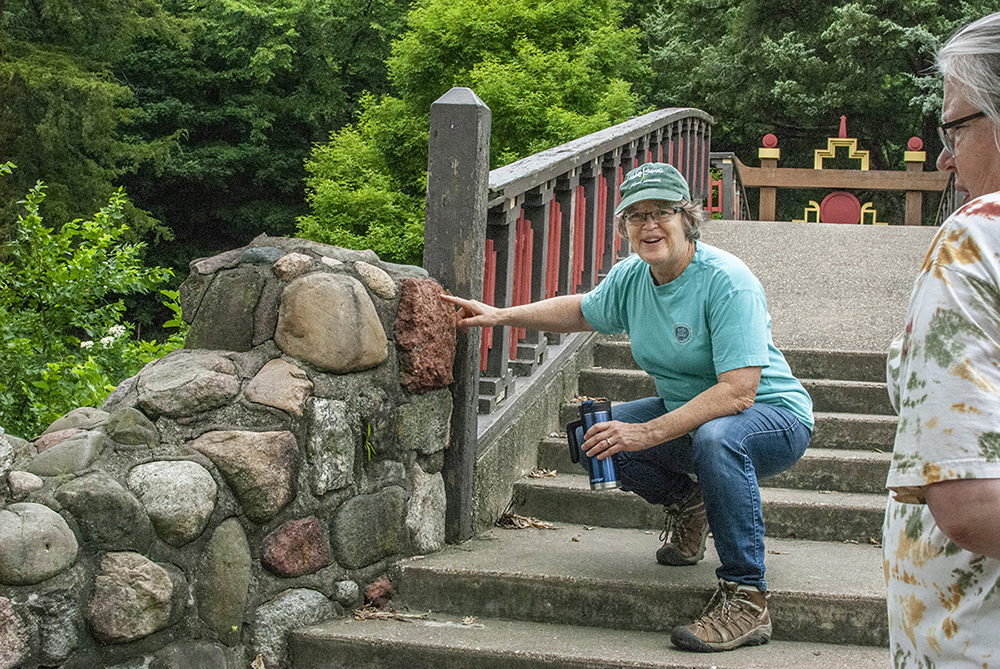
Ed Stermer, geology professor at Illinois Central College, points out glacial deposits on the bank of Kickapoo Creek that runs through the Leslie Rutherford Park in Dunlap. He pointed to a red stone along the shore where he was standing and said it had been carried down from Canada by glaciers. Red rhyolite porphyry stones can be seen throughout the Peoria area and are evidence of glacial deposits. (PHOTO BY DAVID ZALAZNIK)
When Cheryl Resnick moved to Peoria from the arid Southwest, she saw geology from the perspective of Arizona’s sweepingly dramatic landscape linked to ancient geological events and cultural heritage. She saw the absence of all that in central Illinois.
Then she visited Starved Rock State Park and the adjacent Matthiessen State Park. Then she discovered the largely hidden and unrecognized geology of the Peoria region linked to ice ages thousands of years ago, and her vision expanded.
That’s when she and her colleague Ed Stermer began unraveling the amazing geological story of the Kickapoo Creek Watershed.
“The Kankakee Torrent formed Starved Rock and Matthiessen,” said Resnick, professor of earth sciences at Illinois Central College and board member of Friends of Rocky Glen. “What we have here was also formed when natural moraine dams weakened, burst and lakes rushed through here scouring the riverbanks. That’s how Rocky Glen got its unique rounded bowl shape thousands of years ago.”
From glacial moraines, glacial rock deposits, carved canyons and expansive river valleys, central Illinois is replete with vestiges of glaciers, but most are virtually invisible to the uninformed eye.
Discovering, documenting and mapping these sites and hosting educational field trips to these geological formations is a goal of the Friends of Rocky Glen, a not-for-profit organization that raised funds and helped Peoria Park District acquire Rocky Glen. Next goal for the organization is researching and forming a regional “geopark.”
UNESCO recognizes 169 geoparks where the landscape includes sites with international geological significance that should be protected and used for educational programming and tourism. UNESCO-recognized geoparks are in 44 countries.
Tracy Fox, one of the founders of Friends of Rocky Glen, said, “Rocky Glen is phenomenal” and it’s part of our region’s geological story and a key component of the proposed geopark.
Stermer, geology professor at ICC and board member of Friends of Rocky Glen, said the Kickapoo Creek Geopark would give people understanding and sense of stewardship for the environment and help recognize environmental injustice.
He said 80% of Peoria County is in the Kickapoo Creek Watershed. That means most of the chemical runoff from farm fields in Peoria County flows into Kickapoo Creek and is concentrated and drains past Bartonville near the southside of Peoria where there are pockets of poverty, childhood lead poisoning, coal ash drift from the Edwards coal-fired power plant (ordered to close by the end of 2022) and food insecurity.
“Every chemical used in Peoria County comes out through the southside of Peoria,” Stermer said.
The Kickapoo Creek Geopark could help recognize and trigger action on this environmental injustice.
In addition, he said, a regional geopark could facilitate expanded recreational activities like canoeing down Kickapoo Creek, bike riding past glacial moraines and hiking to rocky canyons scoured by glaciers. Lower Bradley Park has a glacial outcropping.
Geotourism is a yet untapped resource in the Peoria area.
A geopark designation would synchronize with work at the 6,000-acre Emiquon preserve south of Peoria. Doug Blodgett, director of river conservation for the Illinois Chapter of The Nature Conservancy, is stationed at Emiquon.
He said work on a Peoria geopark “sounds exciting. The more we can get people out enjoying and learning the importance of these regional sites, the better, higher probability we can create the constituency to protect and sustain the health of these regional gems.”
MacKenzie Taylor, strategic marketing coordinator at Peoria Area Convention and Visitors Bureau, said the bureau is already highlighting Rocky Glen in its literature and marketing outreach. A geopark designation for sites in the area would increase recreational activity and help with promotion of Peoria as a tourism destination.
“Kickapoo Creek has a wonderful geological story,” Stermer said. “The headwaters are north of Dunlap, and it flows past Jubilee College meeting with the west fork from Elmwood and going south of Jubilee where it flows past Wildlife Prairie State Park and down to Darst Street where it exits into the Illinois River.”
Resnick said there are three parts to the geological origins of our region. There is the bedrock geology including deposits of limestone, coal, sandstone and shale dating back 300 million years. There is the evolution and sculpting of the landscape by glaciers during the ice age. And there is the Kickapoo Creek watershed today that covers most of Peoria County.
“Learning these sites is a way to connect with this area and learn the story it has to tell,” Resnick said. “I was a snob, coming from the rocks in Arizona but then learning the story of this region, and it really grabbed me. The story here is unique and can be seen in the circular bowl canyons.”
Stermer said, “Kickapoo Creek cries for explanation. Once you tune your eye to the geology, you understand this region.”
Aug. 14 and 15: “Kickapoo Creek Festival,” organized by Friends of Rocky Glen, is a gathering for education, connection and healing at Wildlife Prairie Park with events for the entire family. Workshops, hikes and tours highlighting the Kickapoo Creek Watershed are scheduled. All are free. For more information go to: friendsofrockyglen.org.

Cheryl Resnick points to rhyolite porphyry in the Japanese Bridge in Lower Bradley Park. The stone was left in the Peoria area in glacial deposits during the ice age. Tracy Fox, right, discusses the concept of creating a geopark in the area and mapping the geological sites of significance. (PHOTO BY CLARE HOWARD)

1 comment for “Kickapoo Creek Watershed: the untold story”
Recent Comments
i am wondering how i can get a printed map of the kickapoo creek.